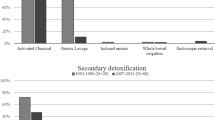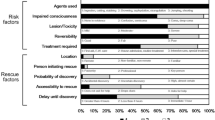Abstract
Emergency management of deliberate self-poisoning (DSP) by drug overdose is common in emergency medicine. There is a paucity of data about the prehospital care of these patients. The principal aim was to describe the intensity of care received by patients with DSP who were managed by prehospital emergency medical service (EMS) physicians. A 48-h cross-sectional study was conducted in 319 EMS and emergency units in France. Patient and poisoning characteristics and treatments administered were recorded. Complications of poisoning, hospitalization, intensive care unit admission and death were recorded until day 30. The primary endpoint was the probability of receiving prehospital intensive care, including fluid resuscitation, vasopressor therapy, invasive ventilation, or antidotal treatments, depending whether prehospital treatment was carried out by an EMS physician or not. Data from 703 patients (median age was 43 [30–52] years, 288 (40%) men) were analyzed. One hundred and fifteen (16%) patients were attended by an EMS physician. Patients attended by EMS physicians were more likely to receive intensive treatment in the prehospital setting [odds ratio (OR) 7.4, 95% confidence interval 4.3–12.9]. These patients had more severe poisoning as suggested mainly by a lower Glasgow Coma Score (13 [8–15] vs. 15 [15–15]; p < 0.001) and a higher rate of admission to an intensive care unit [29 (25%) vs. 15 (2%), p < 0.001]. Patients with DSP attended by prehospital EMS physicians frequently received intensive care. The level of care seemed appropriate for the severity of the poisoning.

Similar content being viewed by others
References
Hendrix L, Verelst S, Desruelles D, Gillet JB (2013) Deliberate self-poisoning: characteristics of patients and impact on the emergency department of a large university hospital. Emerg Med J 30(1):e9
McCaig LF, Burt CW (1999) Poisoning-related visits to emergency departments in the United States, 1993–1996. J Toxicol Clin Toxicol 37(7):817–826
Burillo-Putze G, Munne P, Dueñas A et al (2003) National multicentre study of acute intoxication in emergency departments of Spain. Eur J Emerg Med 10(2):101–104
Maignan M, Pommier P, Clot S et al (2014) Deliberate drug poisoning with slight symptoms on admission: are there predictive factors for intensive care unit referral? A three-year retrospective study. Basic Clin Pharmacol Toxicol 114(3):281–287
Novack V, Jotkowitz A, Delgado J et al (2006) General characteristics of hospitalized patients after deliberate self-poisoning and risk factors for intensive care admission. Eur J Intern Med 17(7):485–489
Beaune S, Juvin P, Beauchet A, Casalino E, Megarbane B (2016) Deliberate drug poisonings admitted to an emergency department in Paris area—a descriptive study and assessment of risk factors for intensive care admission. Eur Rev Med Pharmacol Sci 20(6):1174–1179
Prescott K, Stratton R, Freyer A, Hall I, Le Jeune I (2009) Detailed analyses of self-poisoning episodes presenting to a large regional teaching hospital in the UK. Br J Clin Pharmacol 68(2):260–268
Isbister GK, Downes F, Sibbritt D, Dawson AH, Whyte IM (2004) Aspiration pneumonitis in an overdose population: frequency, predictors, and outcomes. Crit Care Med 32(1):88–93
Barton ED, Colwell CB, Wolfe T et al (2005) Efficacy of intranasal naloxone as a needleless alternative for treatment of opioid overdose in the prehospital setting. J Emerg Med 29(3):265–271
Maignan M, Richard A, Debaty G et al (2015) Intentional drug poisoning care in a physician-manned emergency medical service. Prehosp Emerg Care 19(2):224–231
Matsuyama T, Kitamura T, Kiyohara K et al (2016) Characteristics and outcomes of emergency patients with self-inflicted injuries: a report from ambulance records in Osaka City, Japan. Scand J Trauma Resusc Emerg Med 11(24):68
Lund C, Bjornaas MA, Sandvik L, Ekeberg O, Jacobsen D, Hovda KE (2013) Five-year mortality after acute poisoning treated in ambulances, an emergency outpatient clinic and hospitals in Oslo. Scand J Trauma Resusc Emerg Med 21:65
Thiebaud P-C, Yordanov Y, Galimard J-E et al (2017) Management of upper gastrointestinal bleeding in emergency departments, from bleeding symptoms to diagnosis: a prospective, multicenter, observational study. Scand J Trauma Resusc Emerg Med 25(1):78
Charpentier S, Beaune S, Joly LM et al (2018) Management of chest pain in the French emergency healthcare system: the prospective observational EPIDOULTHO study. Eur J Emerg Med 25(6):404–410
Thiebaud P-C, Yordanov Y, Galimard J-E et al (2019) Suspected lower gastrointestinal bleeding in emergency departments, from bleeding symptoms to diagnosis. Am J Emerg Med 37:772–774
Sporer KA, Craig AM, Johnson NJ, Yeh CC (2010) Does emergency medical dispatch priority predict Delphi process-derived levels of prehospital intervention? Prehospital Disaster Med 25(4):309–317
Feldman MJ, Verbeek PR, Lyons DG, Chad SJ, Craig AM, Schwartz B (2006) Comparison of the medical priority dispatch system to an out-of-hospital patient acuity score. Acad Emerg Med 13(9):954–960
Brett AS, Rothschild N, Gray R, Perry M (1987) Predicting the clinical course in intentional drug overdose. Implications for use of the intensive care unit. Arch Intern Med 147(1):133–137
Adnet F, Baud F (1996) Relation between Glasgow Coma Scale and aspiration pneumonia. Lancet 348(9020):123–124
Duncan R, Thakore S (2009) Decreased Glasgow Coma Scale score does not mandate endotracheal intubation in the emergency department. J Emerg Med 37(4):451–455
Isbister DGK, Bowe SJ, Dawson A, White IM (2004) Relative toxicity of selective serotonin reuptake inhibitors (SSRIs) in overdose. J Toxicol Clin Toxicol 42(3):277–285
Beaune S, Curis E, Casalino E, Juvin P, Mégarbane B (2015) Do serotonin reuptake inhibitors worsen outcome of patients referred to the emergency department for deliberate multi-drug exposure? Basic Clin Pharmacol Toxicol 116(4):372–377
Tan HH, Hoppe J, Heard K (2009) A systematic review of cardiovascular effects after atypical antipsychotic medication overdose. Am J Emerg Med 27(5):607–616
Fouche PF, Stein C, Simpson P, Carlson JN, Doi SA (2017) Nonphysician out-of-hospital rapid sequence intubation success and adverse events: a systematic review and meta-analysis. Ann Emerg Med 70(4):449–459.e20
Lossius HM, Røislien J, Lockey DJ (2012) Patient safety in pre-hospital emergency tracheal intubation: a comprehensive meta-analysis of the intubation success rates of EMS providers. Crit Care 16(1):R24
Gummin DD, Mowry JB, Spyker DA, Brooks DE, Fraser MO, Banner W (2017) 2016 Annual Report of the American Association of Poison Control Centers’ National Poison Data System (NPDS): 34th Annual Report. Clin Toxicol 55(10):1072–1252
Penninga EI, Graudal N, Ladekarl MB, Jürgens G (2016) Adverse events associated with flumazenil treatment for the management of suspected benzodiazepine intoxication—a systematic review with meta-analyses of randomised trials. Basic Clin Pharmacol Toxicol 118(1):37–44
Isbister GK, Dawson AH, Whyte IM (2003) Feasibility of prehospital treatment with activated charcoal: who could we treat, who should we treat? Emerg Med J. 20(4):375–378
Villarreal J, Kahn CA, Dunford JV, Patel E, Clark RF (2015) A retrospective review of the prehospital use of activated charcoal. Am J Emerg Med 33(1):56–59
Ticehurst S, Carter GL, Clover KA, Whyte IM, Raymond J, Fryer J (2002) Elderly patients with deliberate self-poisoning treated in an Australian general hospital. Int Psychogeriatr 14(1):97–105
Acknowledgements
The authors thank Dr. Alison Foote (Grenoble Alpes University Hospital) and Johanna Robertson, Ph.D., for critically editing the manuscript.
Funding
This work was supported by the French Society for Emergency Medicine (Société Française de Médecine d’Urgence, SFMU); and by Grenoble Alpes University Hospital.
Author information
Authors and Affiliations
Consortia
Corresponding author
Ethics declarations
Conflict of interest
The authors declare that they have no conflict of interest.
Research involving human participants
The study was approved by our national Review Board [Advisory Committee on the treatment of information in the field of Health Research- (CCTIRS) the national commission for Liberties and Data Protection (CNIL)] and the ethics committee of Clermont-Ferrand, Grenoble, France (IRB 5891).
Informed consent
According to French law and the observational nature of this study, patients’ oral consent was required. Informed consent was obtained from all individual participants included in the study.
Additional information
Publisher's Note
Springer Nature remains neutral with regard to jurisdictional claims in published maps and institutional affiliations.
Electronic supplementary material
Below is the link to the electronic supplementary material.
Rights and permissions
About this article
Cite this article
Maignan, M., Viglino, D., Collomb Muret, R. et al. Intensity of care delivered by prehospital emergency medical service physicians to patients with deliberate self-poisoning: results from a 2-day cross-sectional study in France. Intern Emerg Med 14, 981–988 (2019). https://doi.org/10.1007/s11739-019-02108-1
Received:
Accepted:
Published:
Issue Date:
DOI: https://doi.org/10.1007/s11739-019-02108-1




